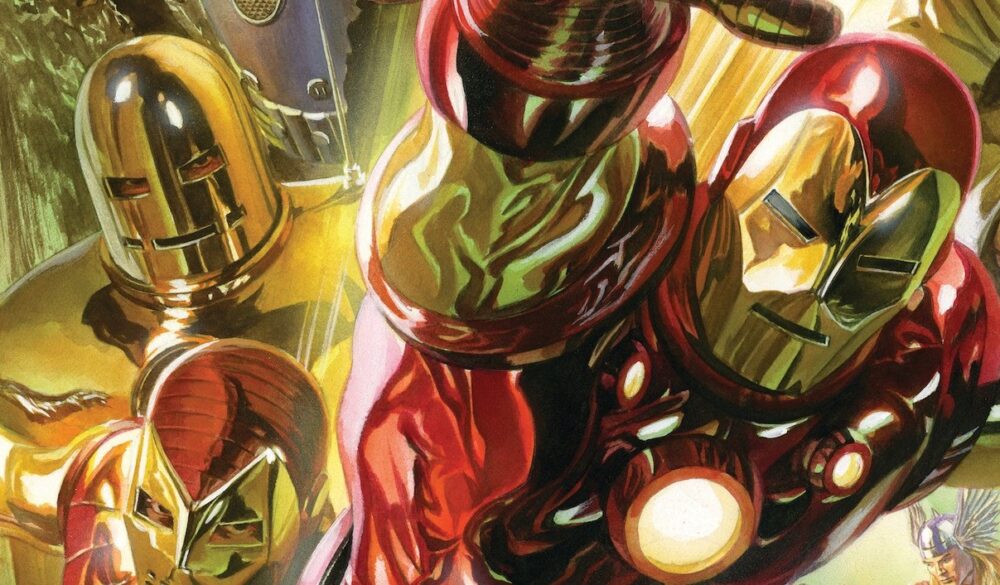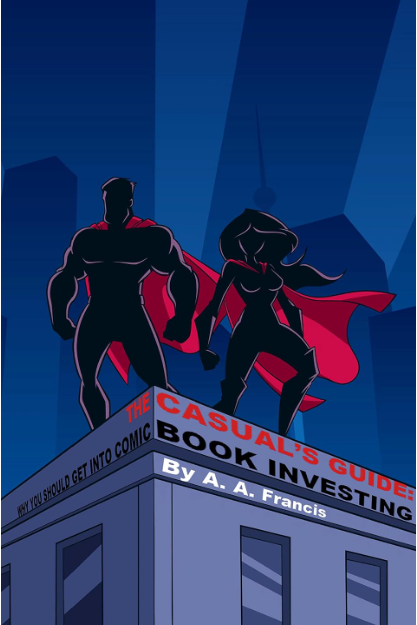There’s More to Iron Man Than the MCU: 4 of the Best Iron Man Stories

The Best Iron Man Stories are in the comic books. (Image courtesy Alex Ross/FB)
The best Iron Man stories are found in Marvel Comics. The problem for most non-comic books reading Iron Man fans is that their idea of Iron Man is Robert Downey Jr.’s portrayal of the character in the MCU films, not necessarily the Marvel Comics character. It can be difficult to find the best Iron Man stories because they span over six decades now.
The Best Iron Man Stories Ever Told
Iron Man was created in 1963 as a comic book exploring the themes of technological advancements, communist panic, the Vietnam War, and celebrity worship. Tony Stark was modeled after Howard Hughes, the Elon Musk of his era when it came to celebrity industrialists.
Dozens of the best Iron Man stories from the 1960s to the 2000s were cherry picked for source material to flesh out RDJ’s portrayal as Tony Stark in the MCU. Tony Stark’s Iron Man armor collection, Extremis, alcoholism problems, womanizing nature, and narcissist tendencies all originated in the comic books, not in the MCU.
To better appreciate RDJ’s portrayal as Tony Stark in the MCU you need to check out the four best Iron Man stories ever told in Marvel Comics. If these stories didn’t exist, RDJ would not have had the source material needed to portray Stark in the MCU.
Superior Iron Man 1: Infamous
Fan-casting has become a toxic part of comic book films and it is a part of why comic book fatigue exists. When you give people, especially fans exactly what they want they don’t appreciate it.
Scandal-scarred director Bryan Singer cast Olivia Munn as Psylocke in X-Men: Apocalypse because comic book fans fan-casted her as the X-Men in fan artwork online. Online fans fan-casted John Krasinski for years as Mister Fantastic and Krasinski made a cameo in 2022’s Dr. Strange: Multiverse of Madness.
The trailer for Multiverse of Madness featured a short sequence featuring an individual flying and shimmering with energy. This hero later turned out to be the Maria Rambeau Captain Marvel variant, but many fans were desperate for it to be Tom Cruise portraying the Superior Iron Man multiverse variant, a fervent fan-casting dream that didn’t materialize.
In 2014, Marvel Comics published an event called “Axis” where the moral compasses of the heroes and villains were reversed. Bad guys had their morality inverted but so did the heroes. Tony Stark, who barely controlled his ego anyway, saw his ego, greed, and arrogance take full control of his personality.
Stark develops a new symbiote-based armor and a free app that helps users bio-hack their own bodies to upgrade themselves any way they want. However, Stark then ups the price to $100 per day to use the app. His arrogance also attracts the attention of his former peers and new enemies.
It’s a fascinating look into how low Tony Stark could go morally if he let his ego take control. And if online fan-casters had their way, Tom Cruise would have portrayed this Iron Man character in Multiverse of Madness. It’s one of the best Iron Man stories that never became adapted for film.
Get it for $11.22 at Amazon now.
Iron Man: Armor Wars Prologue
One thing that people love about RDJ’s portrayal of Iron Man is the way Starl upgrades his armor often and keeps a collection of them around in the same way that a playboy millionaire might keep a collection of luxury cars.
However, this portrayal of Iron Man, and his mindset to upgrade and improve his armor’s capabilities every few months or as technological advancements allowed, first appeared in the comic books way back in the late 1980s.
In the “Armor Wars” storyline, Stark finds out that his armors and technological ideas have been stolen by his enemies. Meanwhile, the federal government decides that his armor are dangerous weapons and wonders about the true motives Stark has as a hero. Stark then has to retrieve his armors and technologies while proving to the Feds that he is not a bad guy.
Sound familiar? These storylines and themes were used throughout all of RDJ’s Iron Man films, especially Iron Man 3. In the 1980s, the idea of Iron Man upgrading his armor often was mindblowing and innovative. Now it is a mundane and expected occurrence in the MCU films. The best way to experience Iron Man is in the comic books.
These are the best Iron Man stories ever published; if it were not for these stories, there would have been no source material for RDJ or the filmmakers to draw inspiration from in his MCU films.
Get it for $13.50 at Amazon now.
Iron Man: Extremis Marvel Select
If the title of this graphic novel looks familiar that’s because it’s the source material for the 2013 MCU film Iron Man 3.
In the comic book, rogue scientists Aldrich Killian and Maya Hansen have created a techno-organic virus called Extremis in an attempt to create superhumans in the way Captain America gained his abilities via the super-soldier serum. Unfortunately, Extremis is being used by terrorists in a literal human arms race.
Tony Stark uses the Extremis virus to save the day, but in the process loses his humanity in the furtherance of science. This story was published in 2006 and was groundbreaking in its portrayal of Tony Stark as a futurist and now just as a technologist or arms dealer. This is the storyline that made Superior Iron Man possible; this is the first story where the Iron Man armor became miniaturized and stored in the bone marrow of Stark’s skeleton.
The line between human and technology became blurred in this storyline. Instead of upgrading his armor every few months Stark literally became the technology he obsesses over. In a way, Tony Stark became a technology-based post-human in the Extremis storyline, not just a smart guy in an Iron Man suit.
Remember, in the MCU films, Tony Stark lost his heart and had it replaced by the Arc reactor technology. Stark’s body helps to power and enhance his armor just as much as any exterior power source. There was something fascinating about watching RDJ’s Stark relate with the J.A.R.V.I.S. AI as if it were human.
And there it was fascinating to watch how badly Stark interacted with human beings in a relative context. Do remember how Tony was having a nightmare while in bed with Pepper in Iron Man 3? His armor was connected to his physiology and sensed when Tony was distressed or in danger, assembled itself, and attacked Pepper as if she was the threat. Tony had to wake up and deactivate the armor; in a way, Tony was more emotionally connected to the inanimate armor than the beautiful woman lying next to him.
The post-humanist problems of a technological genius striving to always improve technology by literally becoming technology started in the Extremis storyline, one of the best Iron Man stories ever.
Fun fact – Rebecca Hall was supposed to be the villain in Iron Man 3. However, businessman Ike Perlmutter, who had more authority than Kevin Feige at the time, would not allow a female villain in a Marvel film. Guy Pierce’s Aldrich Killian became the main villain, even though the character only appeared in the Extremis comic book storyline for one page only.
Get it at Amazon now for $13.45.
Iron Man: Demon in a Bottle
Iron Man 2 was not a perfect film; I really did not like the goofy sequences of RDJ drunkenly partying in his armor. But Stark’s drinking and substance abuse problems portrayed in that film were based on one of the best Iron Man stories ever, Demon in a Bottle.
Published in 1979, Demon in a Bottle depicted Stark’s battle with alcoholism and arch-rival tech genius Justi Hammer. Even though this story debuted in the 1970s, it created the character template of the flawed superhero.
Tony Stark was modeled after eccentric industrialist Howard Hughes in the comic books. However in the Bronze Age of comics, which started in 1970 and ended in 1985, comic book characters began to closely mirror the events of the real world. Before then, comic books usually told good-versus-evil stories without nuance.
The flawed comic book superhero that was previously portrayed as perfect and impervious to temptation became more relatable to readers in the 1970s. This portrayal of Tony Stark as a recovering alcoholic is also an integral part of RDJ’s MCU portrayal.
To fully appreciate RDJ’s portrayal of Iron Man, you need to read Demon in a Bottle.
Get it now at Amazon for $30.73.
Read More
Most Valuable Comic Books of the 1960s
3 Best Comic Book Album Binders
Most Valuable Comic Books of the 1970s
4 Best Mini-Safes to Protect Valuable Comic Books
Most Valuable Comic Books of the 1980s
Top-Tier Comic Art Stor-Folios: The Two Best Options for Your Collection

Allen Francis is a full-time writer, prolific comic book investor and author of The Casual’s Guide: Why You Should Get Into Comic Book Investing. Allen holds a BA degree from Marymount Manhattan College. Before becoming a writer Allen was an academic advisor, librarian, and college adjunct for many years. Allen is an advocate of best personal financial practices including saving and investing in your own small business.

